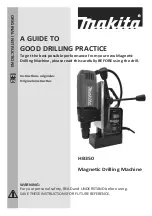
English |
23
Bosch Power Tools
1 619 929 804 | (16.10.07)
Note:
If the tool holder was fully opened to the
stop, a functional ratching sound may be heard
during its next operation and the tool holder will
not close.
In this case, firstly turn the front sleeve
2
in the
opposite direction of the arrow shown in the fig-
ure. Afterwards, the tool holder can be closed
(tightened) again.
Screwdriver bits can be inserted either in com-
mercially available bit holders or directly in the
tool holder.
PBH 240 RE:
Removing Drilling Tools without SDS-plus
(see figure L)
–
Firmly hold the retaining ring
3
of the quick
change chuck. Open the tool holder by turn-
ing the front sleeve
2
in the direction of the
arrow until the tool can be removed.
Dust/Chip Extraction
Dusts from materials such as lead-containing
coatings, some wood types, minerals and metal
can be harmful to one’s health. Touching or
breathing-in the dusts can cause allergic reac-
tions and/or lead to respiratory infections of the
user or bystanders.
Certain dusts, such as oak or beech dust, are
considered as carcinogenic, especially in con-
nection with wood-treatment additives (chro-
mate, wood preservative). Materials containing
asbestos may only be worked by specialists.
–
Use dust extraction whenever possible.
–
Provide for good ventilation of the working
place.
–
It is recommended to wear a P2 filter-class
respirator.
Observe the relevant regulations in your country
for the materials to be worked.
Mounting the Dust Extraction Attachment
(see figure M)
For dust extraction, the dust extraction attach-
ment (accessory) is required. When drilling, the
dust extraction attachment retracts so that the
attachment head is always close to the surface
at the drill hole.
–
Loosen the wing bolt for depth stop adjust-
ment
19
and remove the depth stop
9
.
–
Insert the dust extraction attachment and
tighten the wing bolt again.
–
Connect an extraction hose (diameter
19 mm, accessory) to the extraction sleeve
25
of the dust extraction attachment.
The vacuum cleaner must be suitable for the ma-
terial being worked.
When vacuuming dry dust that is especially det-
rimental to health or carcinogenic, use a special
vacuum cleaner.
Adjusting the Drilling Depth on the Dust Ex-
traction Attachment (see figure N)
The required drilling depth
X
can also be adjust-
ed when the dust extraction attachment is
mounted.
Only for SDS-plus drilling tools:
Insert the SDS-plus drilling tool to the stop into
the SDS-plus tool holder
5
. Otherwise, the mov-
ability of the SDS-plus drilling tool can lead to
incorrect adjustment of the drilling depth.
–
Loosen the wing bolt
29
on the dust extrac-
tion attachment.
–
Without switching the power tool on, apply it
firmly to the drilling location. The SDS-plus
drilling tool must face against the surface.
–
Position the the guide pipe
30
of the dust ex-
traction attachment in its holding fixture in
such a manner that the head of the dust ex-
traction attachment faces against the surface
to be drilled. Do not slide the guide pipe
30
further over the telescopic pipe
28
of the
dust extraction attachment than required, so
that as much as possible of the scale
28
on
the telescopic pipe remains visible.
–
Retighten the wing bolt
29
again. Loosen the
clamping screw
26
on the depth stop of the
dust extraction attachment.
–
Move the depth stop
27
on the telescopic
pipe
28
in such a manner that the
clearance
X
shown in the figure corresponds
with the required drilling depth.
–
Tighten the clamping screw
26
in this posi-
tion.
OBJ_BUCH-495-002.book Page 23 Tuesday, October 16, 2007 3:09 PM
















































